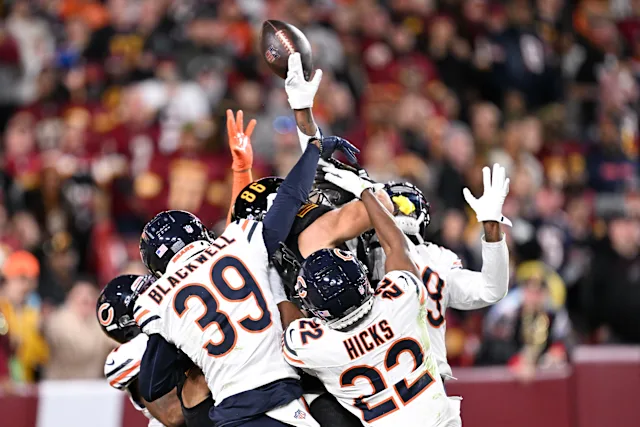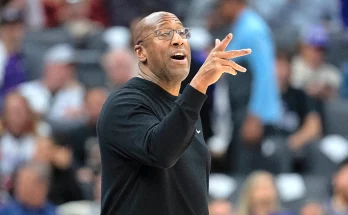The Chicago Bears’ devastating Hail Mary loss—a moment that left fans stunned and silent—may actually be the unexpected catalyst this franchise needed to spark its long-awaited revival. On the surface, it looked like just another crushing moment in a team history filled with heartbreaks, a reminder of missed opportunities and how victory can slip away in the final seconds. But peel back the emotion, and there’s a deeper narrative unfolding. That single play, that brutal finish, might just be the spark that lights the fire for a new era of Bears football—one built on resilience, accountability, and hunger.
Football is a game of inches, of moments, of heart. And nothing tests a team’s soul like losing a game on a last-second heave into the end zone. The Bears were on the cusp of a season-defining win, one that would’ve changed narratives and perhaps masked deeper issues. Instead, the loss exposed every flaw in plain view—coaching miscommunications, defensive lapses, and a lack of killer instinct. But what if that exposure is exactly what this team needed? Sometimes, a gut-wrenching defeat reveals more than a lucky win ever could. It forces players to confront their weaknesses, demands coaches reassess their strategies, and lights a fire under an organization that had grown too comfortable with mediocrity.
After the game, emotions were raw. In the locker room, players were furious—at themselves, at each other, and at how close they came to greatness only to have it ripped away. But those same emotions, when channeled properly, become fuel. Coaches preached accountability, veterans challenged younger players, and a sense of urgency took over the building. No more playing not to lose. No more relying on luck. That Hail Mary loss became a collective wake-up call. Everyone—from the front office to the practice squad—realized that potential alone isn’t enough. Execution is everything.
One of the immediate impacts of the loss was on quarterback Caleb Williams, who had played a near-flawless game up until that final moment. For a rookie, he handled the fallout with poise beyond his years. He didn’t deflect blame. He didn’t shrink from the pressure. Instead, he stepped up and took ownership, declaring that the team would never feel that kind of loss again under his watch. Those are the kinds of words that define leadership—but more importantly, he backed them up in the following weeks with relentless work ethic, sharper decision-making, and vocal presence in the locker room. The loss matured him overnight, forcing him into a leadership role that he’s embraced with the kind of confidence Chicago fans have been starving for.
Head coach Ben Johnson also felt the sting of that loss—particularly the criticism directed his way for late-game decisions and defensive alignment on the final play. But rather than deflect, he owned it in the media, in team meetings, and during film sessions. That kind of accountability set a powerful tone. He didn’t try to spin the loss as a fluke. He framed it as a lesson—a moment the team had to absorb and learn from if they were ever going to grow. In doing so, he gained the respect of the locker room in a way few first-year coaches can. Johnson used the loss as a teaching tool, breaking down every missed assignment and questionable call with brutal honesty, turning it into a blueprint for how not to close games—and more importantly, how to win them in the future.
The front office, too, was shaken by the manner of the loss. General manager Ryan Poles began re-evaluating the roster with sharper scrutiny. Depth pieces were shifted. Veteran leadership was emphasized. Mental toughness became a key trait in every personnel decision that followed. The loss highlighted not just physical gaps, but mental ones—the ability to stay composed in chaos, to outthink opponents in the final seconds. In that regard, the Hail Mary wasn’t just a failure. It was a diagnostic tool. It revealed which players could rise in pressure and which ones folded. And from that data, Poles and his staff began shaping a grittier, more focused team.
Fans, understandably, were livid in the immediate aftermath. Social media exploded with outrage, talk shows blasted coaching calls, and many labeled it the “same old Bears.” But something interesting happened in the weeks that followed. The tone shifted. As the team responded—not with excuses, but with effort—fans started to see something different. They saw players angry not at the refs, but at themselves. They saw a quarterback working overtime, a coaching staff refining its approach, and a team that didn’t sulk after heartbreak—it rallied. The fanbase, long frustrated by apathy and inconsistency, began sensing a culture shift. The Hail Mary loss, while still painful, became a badge of honor—a moment the team refused to let define them.
What’s more, the timing of the loss couldn’t have been more pivotal. Early enough in the season to correct course, but late enough to truly sting. It became the team’s emotional anchor point—the memory they tapped into during film study, on the practice field, and in critical late-game moments. Every rep was harder. Every meeting more intense. Players began holding each other accountable in new ways. Sloppy habits were cleaned up. Communication improved. And most importantly, belief returned. Not blind optimism—but earned belief, forged in adversity.
From a narrative standpoint, that Hail Mary became symbolic. It marked the end of the old Bears—a team haunted by collapses, paralyzed in clutch moments—and signaled the rise of something tougher. Something less fragile. A team no longer afraid of the spotlight. Writers and analysts began noticing, too. The way the Bears carried themselves in post-loss interviews. The way they responded with physical, no-nonsense football in the weeks after. It wasn’t just a reaction—it was a transformation.
Internally, the team began adopting a “never again” mentality. That moment, that loss, that pain—it became their fuel. It united the roster. Defense practiced red zone drills with a renewed sense of urgency. Offensive units focused on clock management and finishing drives. Special teams cleaned up coverage breakdowns. It was as if the entire organization hit a collective reset button, triggered not by a win, but by a brutal defeat. And ironically, it’s that defeat that may be remembered as the true beginning of the Bears’ rise.
Sometimes, teams need to hit rock bottom to rise with purpose. The Bears didn’t lose on a fluke play—they lost on a moment that demanded change. And to their credit, they didn’t ignore that demand. They answered it. They stepped into the fire and came out sharper, more unified, and infinitely more dangerous. It’s rare in professional sports for a single play to have this kind of ripple effect—but that’s exactly what happened. That Hail Mary didn’t just end a game—it ended an era of complacency.
Now, every win that follows, every clutch stop, every late touchdown drive—traces back to that one painful moment. And while it may still sting, it now carries a different kind of weight. Not as a wound, but as a warning. Not as a failure, but as fuel. And when the Bears eventually reach the mountaintop—when they finally turn potential into dominance—it won’t be in spite of that loss. It will be because of it. Because sometimes, the most brutal moments are the ones that build the strongest teams. And in that sense, the Hail Mary loss wasn’t a curse. It was the blessing in disguise that just might save the Chicago Bears.


